► Carrera T vs GT3 Touring
► Which lightweight 911 is best?
► Our head-to-head test
The Gods used to test themselves in these unforgiving hills. Some of the world’s toughest, most skilled drivers have tried and failed to tame the roads above Nice, home of the Monte Carlo rally. This has been the scene of some heroic and messy failures. But also of great success – such as when, 50 years ago, Porsche won the Monte for the first time, in a 911 T driven by Vic Elford.
Here, I’m in another Porsche called 911 T – clearly very different from Elford’s, but it’s not fanciful for Porsche to make the connection between that lithe rally car and this pared-back Carrera. And whereas Elford was dicing with an Alpine, I’m swapping between two Porsches. The other is another relatively low-key, radar-ducking 911: the new GT3 Touring. And although in both cases the image is clean and simple, there’s no shortage of power, precision and thrills.
This frosted yellow 911 T is the automotive equivalent of a sauce that’s been reduced to the maximum: there’s less of it, but it’s more intense and flavoursome. The power output is a relatively scant 365bhp from the twin-turbo 2981cc flat six, the same output as the regular Carrera, although this stripped-down version manages to cost more. The 911 Carrera is not available with the PASM sports suspension set-up, but that comes as standard on the 911 T. Rear-wheel steering is an option. It sits 20mm lower, has a weight-optimised Sport Chrono mode package, shorter transmission ratios on the manual version, a mechanical rear diff lock, 20-inch wheels, a sports exhaust system and some unique styling details.
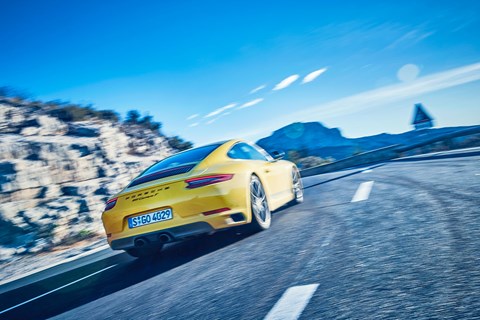
The front spoiler lip has been aerodynamically optimised. The mirror backs are metallic grey. There are various logos, most prominently on the side of the car. And there’s a sports exhaust, centrally positioned, with the pipes painted black.
The weight is down 20kg compared to a similarly specified 911 Carrera, so the power-to-weight ratio is slightly better – improving the manual’s 0-62mph time by 0.1sec to 4.5 – and the focus of the chassis changes is all about making it sharper, keener, quicker. In keeping with that, the gearshift lever is shorter, with a red shift pattern. Sports seats are standard, with a 911 logo stitched into the head restraints, and the seat centres use the technical Sport-Tex fabric rather than anything more luxurious. Bucket seats – not available on the 911 Carrera – are an option.
The modest weight reduction has been achieved by using lightweight glass, minimal sound-deadening material, and loops rather than door handles in the cabin. The rear seats4 and PCM infotainment system can be deleted to further reduce weight and increase the focus on driving. You can also specify a T-only interior treatment that uses contrasting bright colours for some or all of the seatbelts, headrest logo, door loops and seat centres.
Our test car has gone for the yellow trim treatment to match its yellow paint, and everything that can be deleted has been: rear seats, air-con and infotainment, leaving the centre stack one big black hole divided by a slim shelf. The upper cubicle should just about hold a hip flask, while the bottom shelf swallows a pair of sunglasses.
The 911 T is the first Porsche marketed under the Heritage banner; next up will be the GT Speedster due to appear in October. The T suffix in 911 T stands for Touring, which makes you wonder why the other new car here today, the GT3 Touring, is not badged GT3 T. With its 4.0-litre naturally aspirated flat-six producing 494bhp, it follows the same less-is-more theme as the 911 T, swapping the GT3’s massive wing for the stealth variable spoiler of the limited-edition 911R, adding black tints to the front and rear light clusters, abandoning the roll cage and replacing alcantara with leather.
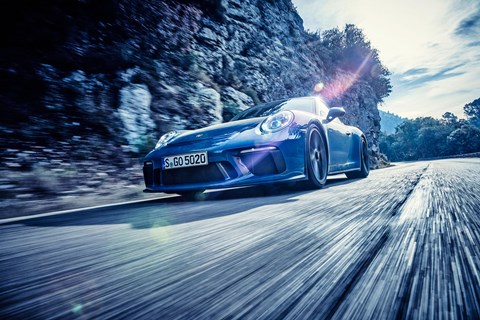
The redesigned front grille carries a GT3 Touring badge, but the body is essentially unchanged; like the GT3, its rear wheelarches are 44mm wider than a 911 Carrera’s. There’s no choice of gearbox: it’s six-speed manual only.
So, we have some great roads and two intriguing cars to drive on them. Fire them up. The moving parts, from brake pads to exhaust flaps, have only just begun to rub the sleep from their eyes, pointing out that it’s zero degrees, so why the rush? Later, the temperature will climb into double figures, but it’s probably just as well that the cars are on soft-compound winter tyres. We’ll take it easy at first.
The 911 T’s 918-derived optional carbonfibre buckets fit like a second skin, punishing that extra sausage at breakfast. Pulling away, the only weight-saving measure you notice is the extra noise thanks to the thinner windows and sports exhaust.
While the GT3 can only be had with a manual six-speeder, the 911 T is offered in two- or three-pedal guise, both of them seven-speeders. Its tall seventh gear allows low-rev driving on the autobahn, but this manual is not one of Porsche’s better gearboxes. It’s painfully slow, vague and excessively long-legged, and operating the lever feels like stirring a sackful of antlers. Go for the PDK paddleshift option.
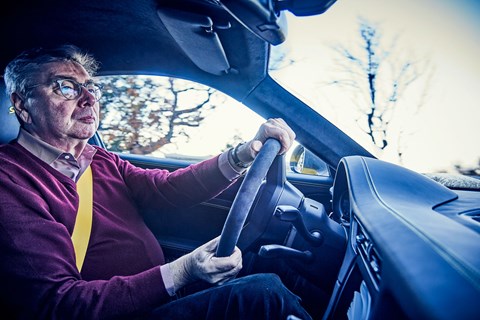
The PDK version is not only more relaxed but also substantially quicker. True, you can regard finding the right balance between the heavy clutch and the sticky gearlever as an emotionally involving exercise in the manual. But is it really more emotional than paddleshifting up and down through the PDK ‘box, exploring the delights of this glorious engine?
And then there’s the story told by the stopwatch. According to Porsche, the 494bhp GT3 Touring can sprint from zero to 62mph in 3.9sec. That’s lightning-fast for sure – and yet the PDK-equipped 365bhp 911 T is only 0.3sec slower than its big-bore brother: three tenths, the batting of an eyelash, half a heartbeat. Pitch the stick-shift model against the two-pedal GT3, and the acceleration gap increases to 0.8sec.
Why was the lean, mean 911 T package paired with the bottom-rung Carrera engine? Because if it had been fitted with the 414bhp version found in the Carrera S, that would in PDK guise narrow the GT3’s 0-62mph advantage to a negligible 0.2sec. The naturally-aspirated 494bhp boxer six of the GT3 would also lose the torque comparison with the turbocharged Carrera S by 339lb ft to 369lb ft.

You’ll have noticed that I’m not entirely convinced by the logic of Porsche’s plan. The best balanced and most accessible Porsche 911 this side of the Turbo remains the 444bhp 911 GTS, which gets to 62mph in 3.7 with a PDK transmission. But, having said that, the 911 T does on certain roads and in certain conditions make the adrenalin pump faster. It loves tight corners, short climbs, deep dips and blind crests, sudden surface variations – the stuff challenging drives are made of.
But to make it truly shine requires some extras and a specific type of journey. Even though they may break the bank, the three options that make the dynamic difference are carbon-ceramic brakes, PDK transmission and rear-wheel steering. Why those hyper-expensive brakes? Because they shrink stopping distances, advance braking points, display riveting stamina and offer unflinchingly consistent pedal travel and pressure. Why steer all four wheels? Because it makes the car turn in with the velocity of a chameleon tongue, because it helps the wheels to juggle torque like a pair of circus seals, and because the high-speed stability matches that of a peregrine falcon diving for its prey. In a nutshell, all three options are key confidence-enhancers, and we all know that confidence is the prerequisite for going really fast.
The ESP system has four settings, the most liberal of which is strictly for drivers of the calibre of Walter Röhrl, which pretty much means just Walter Röhrl himself. You may be encouraged to learn that the two-time World Rally champion admits that he is faster these days with ESP switched on, so good are today’s systems.
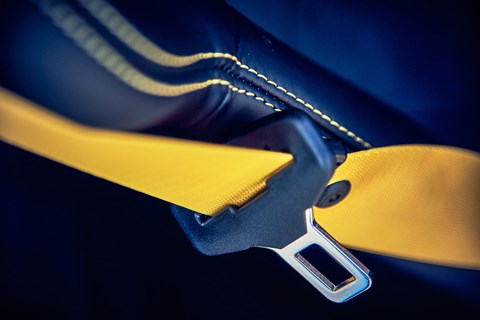
I can now almost sniff the limit of adhesion, yet the front end still turns in with vigour, bites and hangs on. The carbon-ceramic brakes allow us to zoom in on the GT3 at the end of the shortest straight, and a quick downshift flick into first fast-forwards the car through uphill hairpins. Even though there are no straights here long enough to allow the shift into fourth gear, the torque wave is a reassuring 4300rpm wide, encouraging the driver to surf on in third while the 494bhp GT3 Touring in front is still in second.
Switching to the GT3 Touring, it feels very different. It’s barely any bigger, but what actually sets the two 911s apart is the difference in character, not their dimensions. While the 911 T is more sport than touring, the GT3 Touring prefers plenty of room to move, loose radii, roads that open up now and then. It’s in its element when the journey allows you to keep the engine spinning at high revs rather than relying on low-end torque.
On these tight roads, the GT3 Touring spends a lot of time feeling like it’s not getting the chance to shine. The 4.0-litre boxer wants to be revved; below 4000rpm it feels like it’s working to rule. But then you get into the sweet spot between 4000 and 6000rpm and you’re blessed with both a fast-rising torque curve and an even sharper throttle response. But wait – there’s more. The absolute climax is staged from 6000 to 9000rpm, when relentless urge, beautiful noise and that awesome kick in the butt finally put this Touring in a league of its own.
These are both fantastic, extremely focused and highly desirable cars. But that doesn’t stop you hankering for more. Like a moderately more expensive 911 T powered by the 414bhp Carrera S engine, or a GT3 Touring alternatively available with PDK transmission. ‘Dream on’ is Weissach’s official answer to such proposals.
Turbos may be the future but all that’s magical about the 911’s unblown flat-six is alive and well in the GT3 Touring. Pulling to 9000rpm before pausing for another ratio in the Touring’s gorgeously mechanical six-speeder is a special pleasure, the likes of which Generation EV will never understand. The GT3 is simply one of the most spectacularly immersive and engaging sports cars in the world, and the Touring treatment does nothing to change that. Instead it glosses the GT3’s already towering appeal with a little of Porsche’s stellar heritage and a dollop of aesthetic restraint. The result is – surprise, surprise – the most desirable car Porsche makes.
What is a surprise is just how compelling a proposition the Carrera T is. On paper it’s a gimmicky special edition with the potential for very garish seatbelts. On the road it’s all you ever wanted of the boosted Carrera. The T’s accessible (the relatively modest power output and the turbos’ any-rev drive), packs a hugely satisfying chassis (with the right options) and feels genuinely special. The Porsche 911 has a new star in its line-up, and for once it’s at the accessible end.
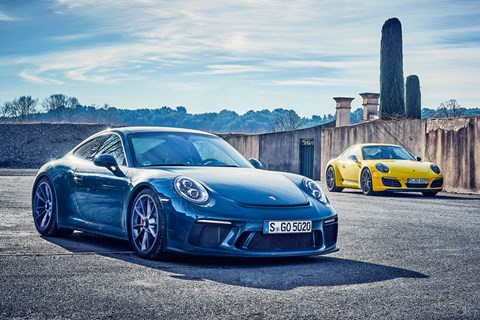
911 Carrera T vs GT3 Touring: specs and verdict
Porsche 911 GT3 Touring – ★★★★★
Price £111,882
Engine 3996cc 24v flat-six, 494bhp @ 8250rpm, 339lb ft @ 6000rpm
Transmission Six-speed manual, rear-wheel drive
Performance 3.9sec 0-62mph, 196mph, 21.2mpg, 302g/km CO2
Weight 1413kg
On sale Now
Porsche 911 Carrera T – ★★★★★
Price £85,576
Engine 2981cc 24v twin-turbo flat-six, 365bhp @ 6500rpm, 332lb ft @ 1700rpm
Transmission Seven-speed manual (or seven-speed PDK auto), rear-wheel drive
Performance 4.5sec (4.2sec) 0-62mph, 182mph, 29.7mpg (33.2mpg), 249g/km (193g/km) CO2
Weight 1419kg
On sale Now
Check out our Porsche reviews here